#Intermarium Support Group
Explore tagged Tumblr posts
Photo
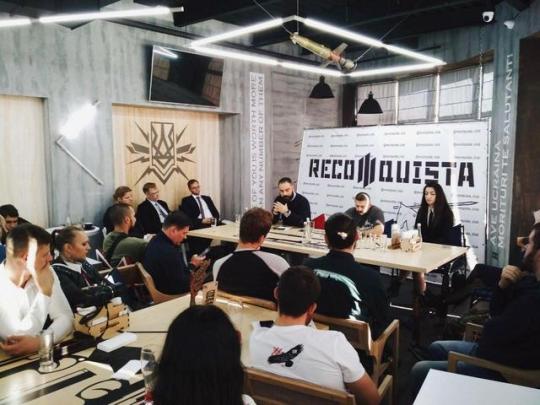



The Azov Movement in the West: achievements in 2019
Despite the fact that the official agenda of National Corps is a course towards Intermarium (Adriatic-Baltic-Black Sea Union), the years 2018 and 2019 were marked not only by regional events of the Intermarium Support Group, founded by Andriy Biletsky, Leader of National Corps, but also by popularization of our project in Western Europe and establishing of cooperation with both friendly Western European parties and those influenced by pro-Russian lobbyists. Along with it, we find sympathizers of Central and Eastern European Union among political forces and media platforms of the United States.
Having engaged in our activities, we adhere not only to the principle of paneuropeanism and alternative universalism, which shall prevent us from regional isolationism in the 21st century. Nor solely to the possibility (yet remote possibility) of the alternative of the EU all-European integration based on Central and Eastern Europe in case of growing animosity and decentralization of Europe.
It is a high time to admit that pro-Russian threat in Europe is tied not only with right-wing populists and “radicals”. After all, such influential right-populist parties like Polish PiS (Law and Justice) and Estonian EKRE (Estonian Conservative People’s Party), which lined up a fifth of seats on parliamentary elections, assume anti-Kremlin geopolitical attitude. Furthermore, namely these parties: both EKRE or Latvian coalition party “National Alliance” – are actual and potential Intermarium Support Group partners.
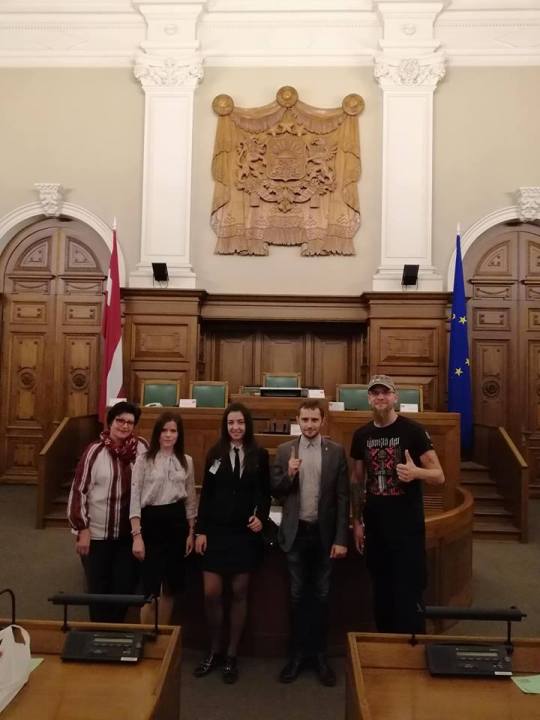
The problem is of another kind: not only a potentially pro-Russian coalition gathers in the European Parliament around the Italian Lega and German AfD – official Berlin, an economic leader of the EU, gradually weakens its resistance against Nord Stream 2, the pipeline which shall be built in circumvention of Ukrainian territory and rests on not only Russian and German but also Austrian, Danish and French funds. Following its own interests, neoliberal European Union persuades Ukraine to “conciliate” with the Russian Federation, which, in its turn, contradicts the interests of the US and some Central and Eastern European Countries only – again, “right-populist”.
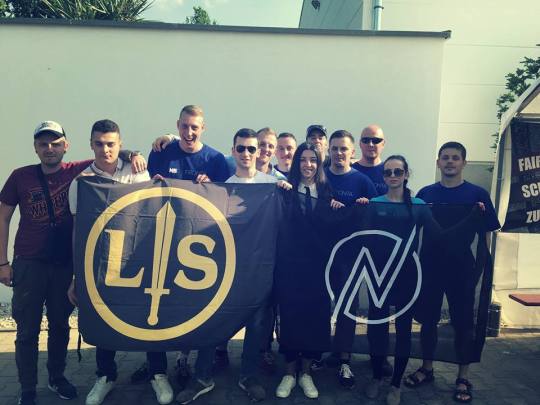
Under such conditions, it is important to prevent the Intermarium Support Group’s activites from deceleration, especially in the light of electoral success of the Finns Party, The Swedish Democrats, Danish People’s Party and other parliamentary forces of the region, which are currently either in the danger zone, or already cooperating with pro-Russian anti-immigration colleagues from Western Europe. Furthermore, given the lack of political unity among such parties, it is worth to give a due time alternative for those willing to think strategically and to avoid the fate of Putin’s fan club.
However, it is no less important to multiply our informational presence in Western European and American informational field via cooperation with “pro-Ukrainian” organizations and even their separate structures.
The starting point of informational expansion of the Azov Movement in the Western European field shall be considered to the Paneuropa Conference, which took place 28 April 2017 in Kyiv under the auspices of all-European Reconquista movement founded in 2015 on the back of mass foreign volunteer support in the National Liberation War in the East of Ukraine. This conference, dedicated to the idea of the alternative to European integration and geopolitical cooperation, gathered representatives of French, Italian, German, Swedish, Croatian, Polish, Lithuanian, Latvian and Russian emigrational political forces supporting a persistent course towards the creation of a sovereign Paneuropean confederation.

On October 15, 2018, the second Paneuropean conference was held in Kyiv, which was visited by local political forces, but also by speakers from Italy, Germany, Norway, Sweden, and the US. Similarly to the constituent conference, it included both the political, party element and the metapolitical component represented by Western intellectuals and bloggers associated with the Third Way, identitarian movement, French New Right (Nouvelle Droite) and American Alt-Right. Both conferences have gathered such prominent Western pro-Intermarium metapolitical thinkers like Gabriele Adinolfi, Pascal Lassalle, Marcus Follin (The Golden One), and Greg Johnson.

Active expansion of the Azov Movement into Western geopolitical and metapolitical sphere has begun with the participation of its representatives Victoria Polunina and Olena Semenyaka in the paneuropean congress named REGeneration Europa, which was organized on May 11-12, 2018, in the German town of Riesa by a youth branch of NPD, Junge Nationalisten. Though a marginal pro-LDNR Russian group was also represented at the conference, which provoked the pro-Ukrainian wing, it was the first mass Western European event marking the start of the further Azov “tour” across Western Europe on the invitations from the interested in the prospects of our cooperation.
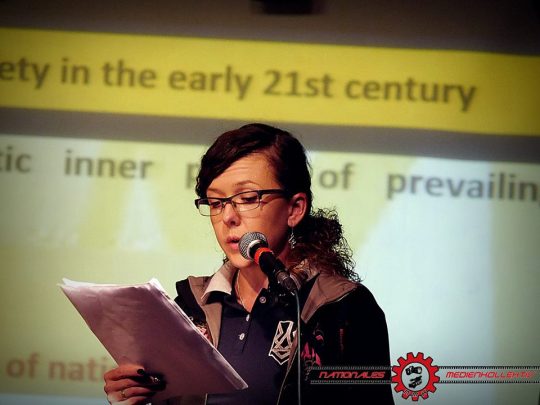
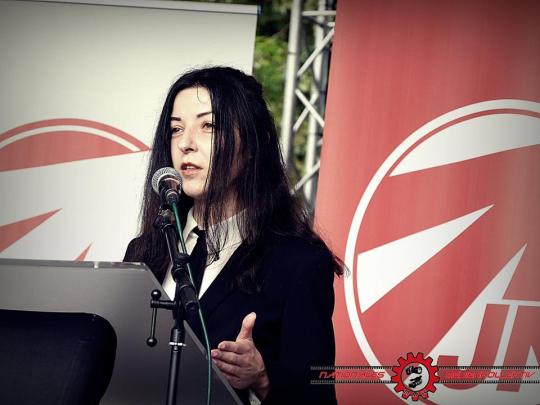
Next year, in spite of a fact that the NPD party has a split on the question of a military and geopolitical conflict between Ukraine and Russia, its youth branch took part in the second Paneuropa Conference in Kyiv and already on February 15-16, 2019 international secretary of National Corps Olena Semenyaka accepted the invitation of the NPD in Saxon Switzerland and the metapolitical center Haus Montag to speak at the event in Pirna in the course of which she described the history of the Azov Movement, the next day after the march in memory of victims of Dresden bombardment.
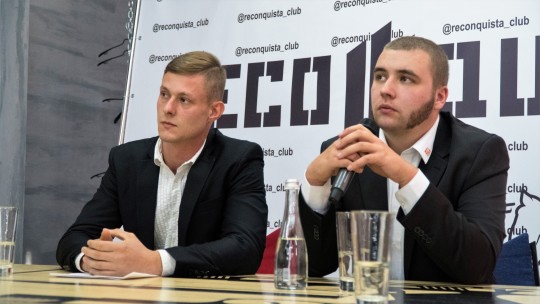
Among all described projects of the Azov Movement, the most challenging, but promising one is the geopolitical program of National Corps: Intermarium defense union as a platform for the alternative to the EU sovereign Paneuropean union. The false rivalry of the West and the Russian Federation creates the unique chance for the intended “buffer zone,” Eastern Europe, to become the center of the restoration of the all-European geopolitical subjectivity.
Moreover, this event was the first in the cycle of events within the framework of the «Ukrainian Year» in Germany, on the initiative of Thomas Rackow, the author of the charity German-Ukrainian-Norwegian Kraftquell (Source of Power) project aimed at organizing the vacation for veteran Ukrainian families in Germany and Norway as a sign of the solidarity of the European family with the belligerent Ukraine. He announced this project during the Paneuropa Conference II in Kyiv and on completion of the speech by Olena Semenyaka in Pirna.

In addition, namely on his initiative, Olena visited the annual convention of autonomous Norwegian nationalists in Eastern Norway who were interested in the geopolitical program of National Corps and supported the Kraftquell project.

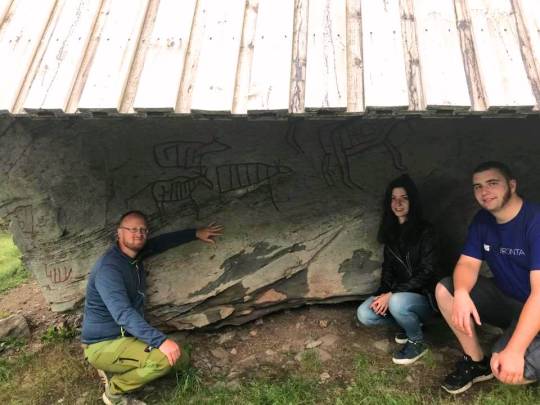
In June 2018, Olena Semenyaka also delivered a speech to the audience of Flamberg Club, the identitarian metapolitical center in Halle, within the framework of an event entitled “Ukrainian Evening: geopolitics, ideas, prospects”. She revealed the basis of Ukrainian state building, identity, the conflict with Russia, history and structure of the Azov Movement and the geopolitical project of Intermarium.
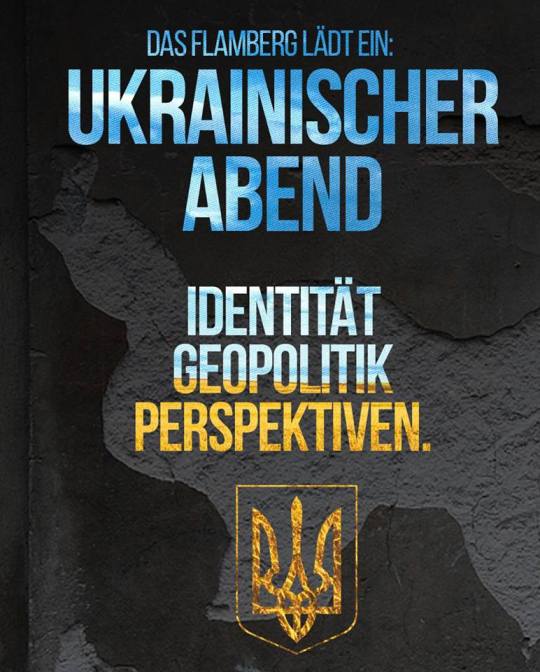
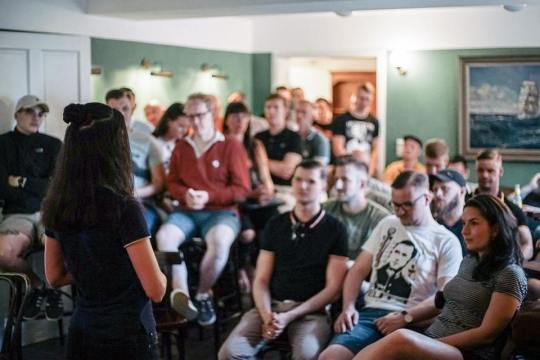
As soon as 3-5 of August 2018, Olena Semenyaka also delivered a lecture at the first Jungeuropa Forum organized in Dresden by Jungeuropa Verlag, the friendly publishing house of identitarian Third Way literature. Olena described to German and Austrian identitarians the geopolitical, cultural and philosophical foundations of Intermarium.
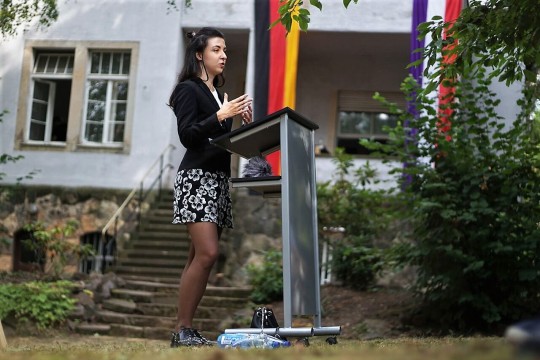
June 7, 2018, Olena Semenyaka revealed the metapolitical strategies of the Azov Movement at the cultural and political event entitled “The Youth Storms” in Kirchheim, Thuringia on the invitation of the German party Der III. Weg (Third Way), a long-time ally of the Azov Movement, the first ones who united with the German branch of the Reconquista Movement in their efforts to destroy the information blockade around the fight of Ukrainian patriots.
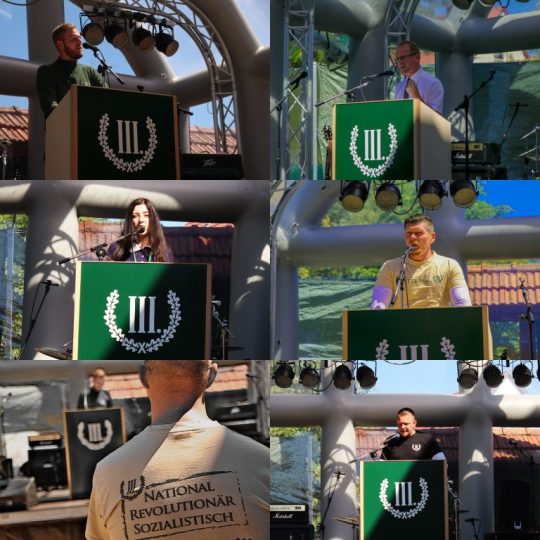
In the wake of the Third Conference of the Intermarium Support Group in October 13, 2018, which, among others, was attended by the representative of the Academic Legion Project of the Ministry of National Defense of Poland Damian Duda and Croatian Armed Force General Brigadier Bruno Zorica, right on February 15-16, 2019, Eugene Vriadnyk, combat veteran of the Azov Regiment, founder of Plomin publishing house, delivered a speech on his vision of archeofuturistic future of Central and Eastern Europe at the Prabudimas Conference in Vilnius, as well as took part in a torchlight procession in honor of the anniversary of Lithuania’s independence, which were organized by the Kryptis ethnofuturist association.

January 7, 2019, Olena Semenyaka participated in the commemoration of three young Italian patriots killed by communists in Acca Larentia massacre. The march, dedicated to the bloody event of the Lead 70-s, has become an all-Italian sacral rite precisely thanks to the activity of Casa Pound Italia. This organization has also brought this event even to the all-European and transcontinental level, gathering participants as far as from Quebec. This visit has strengthened the partnership with CasaPound Italia represented by their international correspondent Alberto Palladino at the Second Paneuropa Conference in Kyiv.
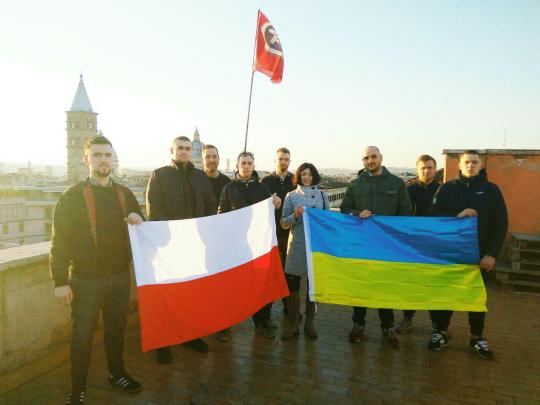
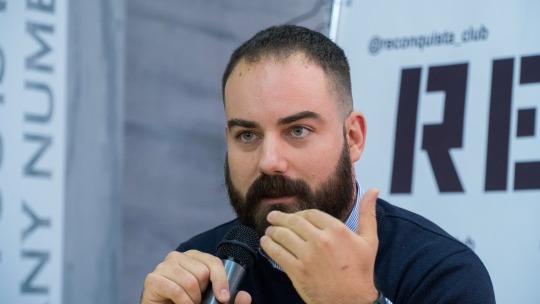
Besides, National Corps has been a participant of the Third Etnofutur Conference, which took place on the 23rd of February in Tallinn. This event is held annually by the youth organization of Estonian People’s Conservative Party (EKRE), Blue Awakening (Sinine Äratus). Traditionally, the strong emphasis has been laid on the conceptual synergy of the nationalist speakers of the Intermarium region. Olena Semenyaka has delivered a speech entitled “Middle Europe in the Age of Caesarism and the Purpose of Ethnofuturism”. In her speech, she mentioned that namely the Azov Movement is the brightest example of Ethnofuturism as a combination of innovative technologies with the policy of protecting ethnocultural identities.

Having referred to Oswald Spengler’s concept of Caesarism as the final period of the historic cycle of the West which began with the first world war, Olena presented Intermarium as space where Old Europe can return to life again entering a new cultural and civilizational turn.
In addition, National Corps sent his representative to support EKRE ahead of parliamentary elections. Fortunately, the allied party showed an exceptionally high result. On February 24, Olena, also traditionally, participated the celebration of the independence of Estonia and anniversary torchlight parade.
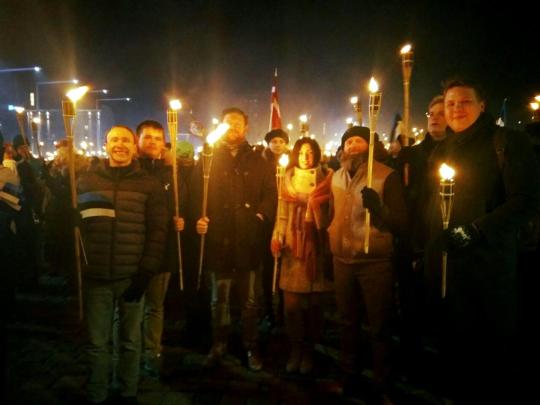
On March 30, 2019, Olena Semenyaka spoke at the Pan-Scandinavian Scandza Forum founded by Fróði Midjord. The forum addressed the problems of the lacking freedom and imported chaos in modern Western societies (”Anarcho-Tyranny”). Having investigated the issue in the context of Ernst Jünger’s criticism of neo-totalitarian police state, as well as the need to put modern audiovisual technologies into service of our own historical visions, she called the region of Central and Eastern Europe the space of political freedom where it would be possible to develop the paneuropean infrastructure for such purposes. The event was also attended by members of Swedish Democrats and Alternative for Sweden.
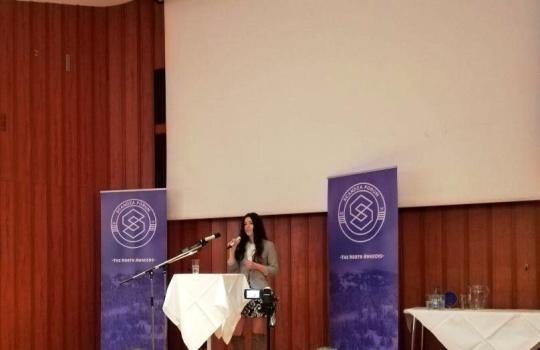
After the Scandza Forum, Olena Semenyaka became the guest of the “Anton och Jonas” video program during which she discussed the course of the Maidan Revolution, the reasons for the geopolitical confrontation with Russia, the milestones of the formation of the Azov Movement and the Intermarium project. Her interlocutors were Anton Stigermark, the representative of the Alternative for Sweden party, the author of the “Memetic Warfare”, who also participated in the MMA tournament at the Kyiv Reconquista Club, and Jonas Nilsson, coordinator of the Boer Project, also the MMA enthusiast and a former instructor of the Azov regiment, which hosted a lot of Swedish military volunteers.
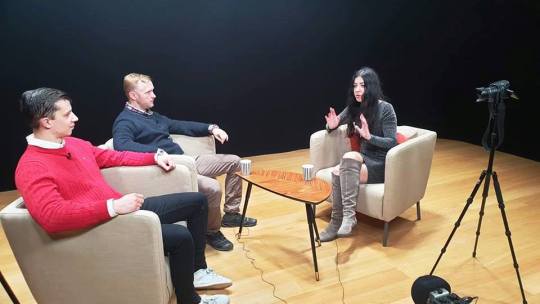
Finally, on April 6, 2019, the National Corps, represented by the international secretary and coordinator of the Intermarium project Olena Semenyaka, took part in the Awakening II Сonference in the Finnish city of Turku. At this conference, Olena made a presentation "Finnish-Ukrainian Cooperation Then and Now As Seen by National Corps” during which she discussed the diplomatic cooperation of Finland with the Hetmanate and the UPR in the previous century, in particular, thanks to the ardent Finnish advocate of the Ukrainian national liberation movement Hermann Gummerus, as well today’s step-by-step integration program of the Intermarium Support Group.
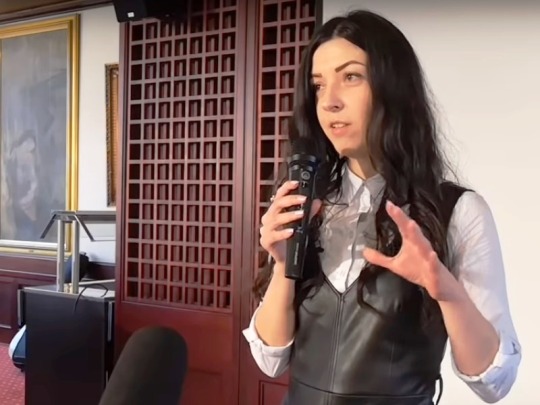
In addition to foreign speakers and guests, the event was visited by members of the Finnish identitarian organization Suomen Sisu and the youth branch of the Finns Party. Finnish audience, which had its own experience of Russian-Finnish wars, was fascinated by the natural geopolitical vector towards Intermarium. It is worth to mention that the Finns Party has lined up 39 parliamentary seats out of 200 during the recent election.
It is planned that Olena Semenyaka will take part in Forum Prisma Actual on May 4, 2019, in Lisbon, on the invitation of Escudo Idetitario, Portuguese identitarian organization. Along with developed Spanish branch of the paneuropean Reconquista movement, Portuguese patriots couldn`t help resonating with the cause of the novel Ukrainian “conquistadors.”

Among the Southern European countries, the great interest in Azov’s activity is shared by Greece whose patriotic audience also feels the cultural and geoeconomic affinity towards the project of Intermarium and invite National Corps to their land.
However, the priority of the Intermarium Support Group for the second half of 2019, of course, is holding the Fourth International Conference bringing the regional European integration to the new level. According to preliminary plans, the conference will be held in Zagreb, a center of the Adriatic angle of Intermarium.
#National Corps#AZOV movement#Andriy Biletsky#Intermarium Support Group#Olena Semenyaka#eugene vriadnyk#Paneuropa#reconquista movement
4 notes
·
View notes
Text
Clara Weiss
14 November 2017
On Saturday, November 11, at least 60,000 fascist demonstrators from Poland, Hungary and Slovakia gathered in Warsaw, the Polish capital, on Poland’s “Independence Day” to stage what has been described as the biggest far-right demonstration since the fall of Nazism. Some estimates suggested as many as 100,000 participants.
The rally was organized by a variety of far-right groups, including the Polish National-Radical Camp, the National Movement and the All Polish Youth, all of which are anti-Semitic and white supremacist. The historical antecedents of these forces were responsible for violent anti-Semitic pogroms in the 1930s, and helped the Nazis hunt down Jews during the German occupation, even when they themselves were persecuted by the Nazis.
Slogans at the rally effectively called for an ethnic purge of Europe. Banners read: “White Europe of Brotherly Peoples,” “Europe will be White or Depopulated,” “Pure Poland, White Poland!” “Death to the Enemies of the Fatherland,” “Pray for Islamic Holocaust,” and “Refugees, Get Out!” Marchers waved Polish flags and carried burning torches. Some also displayed the falanga, the main symbol of Polish fascism.
Thousands of fascists and ultra-nationalists travelled from other countries to attend the march, including from Sweden, Hungary and Slovakia. The well-known American white supremacist Richard Spencer was invited to speak at the rally but was apparently banned by the Polish government from traveling to the country.
Nothing about this demonstration was spontaneous or accidental. It was a carefully planned provocation and show of strength by the Eastern European far-right, aimed at intimidating everyone opposed to the right-wing shift in European and international politics and the ever more feverish war preparations. It was consciously staged in a city that was all but destroyed in 1944 by the German Wehrmacht, and whose Jewish population was wiped out in Auschwitz and Treblinka. Poland suffered some five million losses under Nazi occupation, three million of them Jews, and was the main site of the industrial extermination of European Jewry.
The fascist forces that have now unabashedly and provocatively shown themselves in Warsaw have been strengthened and even armed, by both right-wing governments in Europe, and US imperialism.
The slogan of the demonstration was “We Want God,” the words from an old religious Polish song that US President Donald Trump quoted during his July visit to Warsaw. As the WSWS noted at the time, Trump was deliberately whipping up fascist sentiments and religious bigotry in a speech that implied support for anti-Semitism, nationalism, Catholicism and white supremacy.
Moreover, during this visit, Trump signaled the full support of the White House for Polish Law and Justice (PiS) government plans to build a so called Intermarium (between the seas) alliance of states in Eastern Europe, directed against both Russia and Germany. Historically, attempts to build such an alliance were always centered in Poland, which has thus sought to become a regional power, while relying on fascist and ultra-nationalist formations in Eastern Europe, including Ukraine, Romania, and Slovakia. It is these forces to whom Trump appealed in his speech, and they understood it very well.
Even before the Trump administration took office, the US government had worked to strengthen the far right throughout Eastern Europe, most notably in Ukraine. The US-orchestrated coup in Kiev in February 2014 critically relied on the country’s fascist forces. They have been given almost free rein in the ongoing civil war that has ravaged the country ever since. Formations such as the Azov Battalion, which played a major role in the coup, have been employed to fight separatist troops in eastern Ukraine and terrorize the local population. Like so many far-right groups in the region, the Azov battalion openly advocates a resurrection of the Intermarium alliance.
The Law and Justice government in Warsaw has done its part to strengthen the far right ever since it won a parliamentary majority in the fall of 2015. It has constantly promoted xenophobia, anti-Semitism, nationalism and militarism. Moreover, there are an estimated 400,000 people involved in paramilitary organizations dominated by far-right ideologies in Poland, a country with a population of less than 40 million. The Defense Ministry has undertaken to arm these forces and integrate them into a paramilitary militia that is being established parallel and, to some extent, in opposition to, the country’s regular armed forces.
It is thus no accident that the Polish Interior Minister Mariusz Błaszczak praised the demonstration: “It was a beautiful sight. We are proud that so many Poles have decided to take part in a celebration connected to the Independence Day holiday.” Other sections of the Polish government, including the Foreign Ministry, issued similar statements.
Polish President Andrzej Duda condemned the demonstration, arguing that there was no room for xenophobia and nationalism in Poland. Under conditions of growing social and political opposition to the PiS government, Duda has tried to distance himself from the government’s policies over the past year. But he too is responsible. Not only has he played a key role in propping up the PiS-government by playing the role of a mediating buffer between the government and the opposition. He was also one of the first to proclaim the building of an Intermarium-style alliance as official governmental policy when elected president in the summer of 2015.
The resurgence of the far-right in Eastern Europe, which was the site of some of the greatest crimes in the history of humanity, perpetrated by the German National Socialists and their local fascist allies, is a stark warning to the international working class. As in the 1930s, the bourgeoisie is preparing for war and the suppression of social revolution by building up the far right.
2 notes
·
View notes
Text
#gallery-0-4 { margin: auto; } #gallery-0-4 .gallery-item { float: left; margin-top: 10px; text-align: center; width: 25%; } #gallery-0-4 img { border: 2px solid #cfcfcf; } #gallery-0-4 .gallery-caption { margin-left: 0; } /* see gallery_shortcode() in wp-includes/media.php */
Map of the proposed Intermarium, a federation of Central and Eastern Europe
Map of the proposed Technate of America (Technocracy Inc.)
Still from a 1941 German propaganda film about the invasion of Yugoslavia
Map of the bioregion of Cascadia (Pavel Zuk)
The world could soon add two new countries. In Catalonia and Kurdistan, referendums have been held to secede from Spain and Iraq, respectively.
Neither would be universally recognized. Spain doesn’t even recognize a Catalan right to self-determination. Iran, Iraq and Turkey all oppose Kurdish statehood.
International recognition is often a stumbling block for would-be states. Consider the likes of Kosovo, Somaliland, South Ossetia and Transnistria.
Others don’t even get to that point. Here is a selection of countries that remained on the drawing board.
Intermarium
Map of the proposed Intermarium, a federation of Central and Eastern Europe
The Intermarium (“between seas”) was a Polish proposal for the federalization of Central and European Europe.
Poland’s post-World War I leader, Józef Piłsudski, was the most prominent proponent of the scheme, but it dates back to the early nineteenth century. Adam Jerzy Czartoryski, a leader of the 1831 Polish uprising against Russia, also supported it.
Outside Poland, the plan met little sympathy.
The Soviets opposed it, because they wanted the Baltic states, Belarus and Ukraine for themselves. The Western Allies were against it, because they assumed Bolshevism would eventually collapse and they still thought of Russia as a counterweight to Germany. Many of the federation’s prospective members saw it as a thinly-veiled attempt to resurrect the Polish-Lithuanian Commonwealth.
North American Technate
Map of the proposed Technate of America (Technocracy Inc.)
The Great Depression gave various new political philosophies a lease on life. Chile lurched to the far left. Brazil and Portugal turned to the corporatist right. Germany elected the Nazis. In Canada and the United States, the technocracy movement arose. It proposed replacing all politicians with specialists: economists, engineers, scientists and businesspeople.
Franklin Roosevelt’s New Deal, which was also premised on expert control of the economy, took the wind out of the technocrats’ sails. In Canada, the movement was even outlawed for a while.
The most prominent advocacy group was Technocracy Incorporated, founded by Howard Scott. It wasn’t very popular and — in what certainly didn’t bode well for their ability to govern — ridden by factionalism.
Their farthest-reaching proposal was to unite Central and North America into a “technate”, their argument being that the natural boundaries and resources of the area stretching from the Arctic to Panama made it “an independent, self-sustaining geographical unit.”
SS State of Burgundy
Nazi leaders Adolf Hitler and Heinrich Himmler meet at the Wolf’s Lair military headquarters near Rastenburg, October 13, 1943 (Ullstein Bild)
Burgundy, now a region in central France, has historically been all over the map of Western Europe. The medieval Kingdom of Burgundy straddled the Mediterranean coast. The Duchy of Burgundy, at its greatest extent, ran from the Low Countries in the north to Lake Geneva in the south. The Burgundian Circle was part of the Holy Roman Empire.
During World War II, SS chief Heinrich Himmler argued for the restoration of an independent Burgundy — outside the Greater German Reich, which would colonize the northeast of France, but under National Socialist rule.
Himmler imagined himself as regent. Léon Degrelle, the leader of the Belgian fascists, was supposed to become the state’s first chancellor.
SS Burgundy would encompass what are today the Champagne, Franche-Comté and Picardy regions of France, giving the state access to the English Channel, as well as French Switzerland and the Belgian provinces of Hainaut, Luxembourg and Nevers. Either Dijon or Nancy would have been designated as the capital.
It’s unclear how supportive Adolf Hitler was of Himmler’s dreams. Little serious planning appears to have gone into this.
Balkan Union
Still from a 1941 German propaganda film about the invasion of Yugoslavia
An alternative to the Intermarium, the Balkan Union would have seen Greece and Yugoslavia leading the way in federating the Balkans and Central Europe.
The plan was concocted by Britain’s wartime foreign secretary, Anthony Eden, who convinced the heads of the Greek and Yugoslav governments-in-exile to take the first step. His hope was to draw in Nazi-allied Albania, Bulgaria and Romania after the war.
The two countries’ monarchies were to be merged with a marriage of the Greek princess Alexandra and the young king Peter II of Yugoslavia.
A third step would have been to combine the Balkan Union with a Polish-Czechoslovak Confederation and create an enormous buffer state between Western Europe and communist Russia.
The plan was abandoned after a year, when the Allies decided to support Josip Tito’s communists against the Nazis.
After the war, Tito moved Yugoslavia into Russia’s orbit. American and British support for the royalists in the Greek Civil War kept that country in the Western camp.
Alexandra and Peter, who did marry, never set foot in Yugoslavia again.
Balkan Federation
Joseph Stalin and Georgi Dimitrov, the communist leaders of the Soviet Union and Bulgaria, wave at crowds in Moscow’s Red Square
Leftists had been discussing their own plans for Balkan confederation for decades.
The earliest proposals, for a socialist federation stretching from the Alps to Cyprus, date from 1885.
The 1910 Balkan Socialist Conference in Belgrade called for workers’ unity in the face of the coming First World War.
After the Bolshevik Revolution, the Soviet Union’s Comintern actively promoted a Balkan Federative Republic of Bulgaria, Greece, Turkey and Yugoslavia.
The closest the plan came to fruition was after World War II, when the Bulgarian and Yugoslav communist leaders, Georgi Dimitrov and Tito, tentatively agreed to merge their countries. This was interrupted when Tito fell out with Soviet leader Joseph Stalin in 1948 and Bulgaria was compelled to follow Moscow’s line.
Fertile Crescent Plan
Detail from a 1993 map of the Middle East, showing the years in which countries gained their independence (CIA)
Britain reneged on its promise of a united Arab homeland after the First World War. Instead, it and France created the kingdoms of Iraq and Transjordan, ruled by the brothers Faisal and Abdullah, respectively, as well as Mandatory Palestine under direct British rule and Mandatory Syria under the French.
During World War II, Syria fell under the control of Nazi-allied Vichy France. Syria declared itself independent in 1941, but this wasn’t recognized by the Western Allies until 1944.
Sensing an opportunity for Arab unity, Iraq proposed bringing the four countries together. It was called the Fertile Crescent Plan.
It wasn’t popular in Syria, though, where there was little desire to live under a pro-British monarch.
Arab Islamic Republic
Presidents Houari Boumedienne of Algeria and Anwar Sadat of Egypt meet with Colonel Muammar Gaddafi of Libya for a conference, May 8, 1972 (Keystone/Getty Images)
Muammar Gaddafi spent his first decades in power attempting to unify the Arab world. He convinced Egypt and Syria to join Libya in a Federation of Arab Republics in 1972, but this collapsed five years later. Between 1978 and 1987, Gaddafi’s army routinely intervened in neighboring Chad with the goal of bringing that country into Libya’s fold.
In the early 1970s, Gaddafi set his sights on Tunisia. Visiting Tunis, the Libyan leader rallied support for a merger of the two North African states.
Tunisia’s Habib Bourguiba was suspicious. The president, in power since 1957, worried that, with Libya in a federation with Egypt, merger would only expand Egypt’s influence westward.
For unknown reasons, Bourguiba came around in 1974. He signed a declaration with Gaddafi on the island of Djerba that year which committed the two countries to unification. The plan was for Bourguiba to become the president of the joint republic and Gaddafi the head of its combined armed forces. Referendums were meant to be held to ratify the accord, but internal Tunisian as well as Algeria opposition scuttled the deal within days.
Quebec
Quebec depicted on a 1922 map of Canada
French-speaking Quebec came close to seceding from Canada in 1995, when 49.4 against 50.6 percent of its residents voted for independence. Separatism has waned since, but Quebec retains its own identity.
The area was part of eighteenth-century “New France”, which stretched all the way south through Louisiana (named after King Louis XIV) to New Orleans (after the French city of Orléans). After France’s defeat in the Seven Years’ War, it traded its Canadian territories with Britain for Guadeloupe.
The British allowed the settlers to continue living under French civil law and practice their Catholic religion, gestures which helped prevent the sort of revolutionary sentiment that was brewing in the Thirteen Colonies to the south.
Nowadays, the French language and French-Canadian culture are protected by the Canadian Constitution.
Cascadia
Map of the bioregion of Cascadia (Pavel Zuk)
It wasn’t until the middle of the nineteenth century that the United States started to incorporate the territories west of the Rocky Mountains. Some of the early settlers favored independence. As late as 1860, arguments were made for a “Pacific Republic”. A separatist movement was active in Oregon before the Second World War.
In more recent years, the Pacific states on either side of the American-Canadian border have cooperated on matters of commerce, environmental policy and transportation.
The regions are abundant in natural resources and home to some of the world’s largest companies, including Amazon, Microsoft, Nike and Starbucks. Combining British Columbia, Oregon and Washington state would create a viable nation of sixteen million. The progressive, eco-friendly sensibilities of Portland, Seattle and Vancouver would also go well together, but the constitutional obstacles to first seceding and then combining are probably insurmountable.
Countries that almost existed: From the Intermarium to the North American Technate The world could soon add two new countries. In Catalonia and Kurdistan, referendums have been held to secede from Spain and Iraq, respectively.
0 notes
Photo

"Питання біженців" - каталізатор становлення Інтермаріуму:
- Падіння рейтингів прихильників "відкритих кордонів", зокрема, символічний програш "Християнсько-демократичного союзу" Ангели Меркель і сходження антиімігрантських партій.
- Спротив країн Вишеградської п'ятірки (Хорватія, Польща, Чехія, Угорщина, Словаччина) розподілу "мігрантських квот" та їхні вимоги запобігати самим причинам потрапляння "біженців" у Європу. Консервативний виклик "прогресивним" цінностям з боку Польщі й Угорщини;
- Угода ЄС з Туреччиною щодо обміну мігрантів "один за один" (18.03.2016) та її запізнілість на тлі терактів у Анкарі (13.03.2016) та Брюсселі (22.03.2016) “The refugees issue” as a catalyst for Intermarium`s foundation:
- dercrease of the “open borders” supporting rate, significant defeat of Angela Merkel`s “Christian Democratic Union” and increase of support for anti-immigrant parties in particular;
- refusal of the Visegrad group member countries (Croatia, Poland, the Chech Republic, Hungary, Slovakia) to distribute the s0-called “migrant quotas”, demands from their side to eliminate the root causes for the immigrant disaster in Europe. Conservative opposition of Poland and Hungary to “progressive” values of EU;
- the agreement between the EU and Turkey on migrants exchange (18\03\2016) and its untimely implementation due to terrorist attacks in Ankara (03\13\2016) and Brussels (03\22\2016).
0 notes
Photo
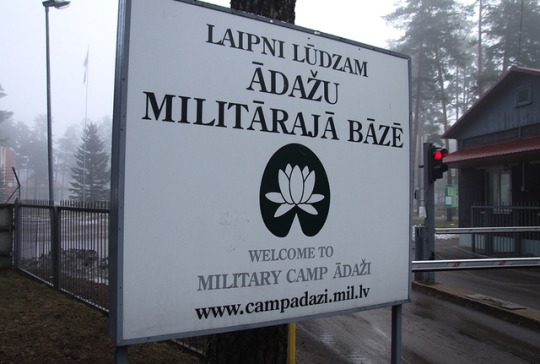

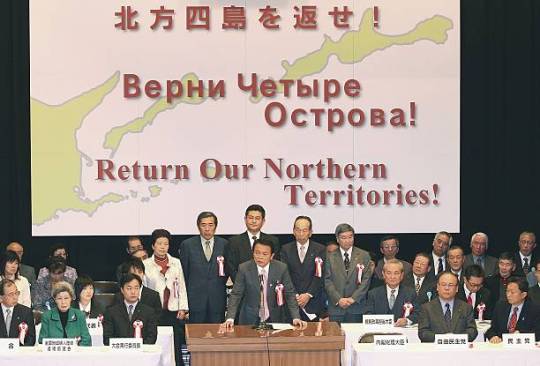
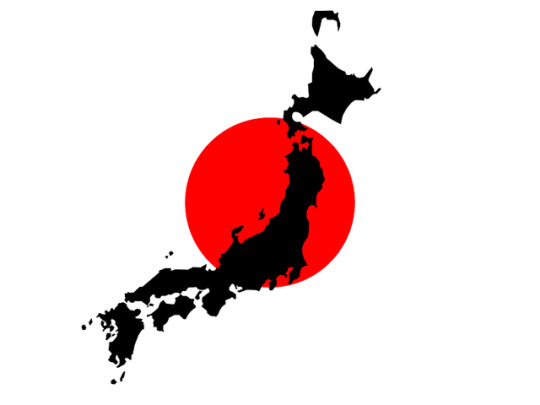
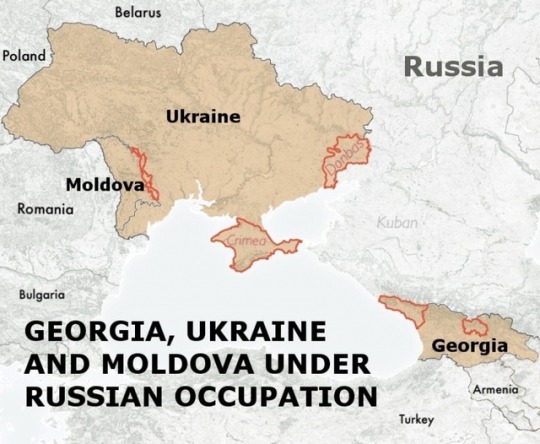
Only sovereign military forces will protect the Intermarium countries
Feb. 5, 2019 Latvian Defense Minister Artis Pabriks was authorized by the government to sign a memorandum on the establishment of the Multinational Division Headquarters North. It will aslo be signed by Danish and Estonian Defense Ministries, as well as will be open for other allies, quite logically, above all, regional. Allies from Canada, Great Britain and Lithuania have also signed the agreement. The infrastructure at Ādaži base in Latvia is under construction.
While the Headquarters North is aimed at increasing the presence of NATO in the region under threat of the military buildup in the bordering Russian territories, it will enhance the defense coordination of the Intermarium region's countries and will develop practical framework for the planning of joint military operations (interaction of the officers, units and structures of different countries, military trainings and exchange of experience and so on). In this respect, it is quite similar to the tasks of existing LITPOLUKRBRIG (the Lithuanian-Polish-Ukrainian multinational brigade). At some point, one could set a task of coordinating the military cooperation of two multinational brigades.
At the same time, the issue of the formal subordination of the LIPOLUKRBRIG was widely addressed at the Third Conference of the Intermarium Support Group which was held in Kyiv on Oct. 13, 2018. In short, conference participants were concerned about the inability to apply the military forces of this multinational brigade even in the peacemaking humanitarian missions in Donbas without the permission of the UN, EU and NATO. Croatian participants also made it clear that their path to victory lied through ignoring rather than taking into accout the will of the West. In this case, one could fairly ask: what's the point in regional military forces if the region has no geopolitical sovereignty to take decisions on its own about the necessary security measures?
In this respect, the founder of the Intermarium Support Group, MP Andriy Biletsky was wise enough not to vote today in favor of the legislative bill to amend the Constitution of Ukraine by adding there an artilce about Ukraine's strategic course to enter the EU and NATO, which he fairly labeled as laughable. Firstly, nobody welcomes Ukraine in these structures, secondly, they undergo an obvious crisis, thirdly, the Constitution regulates universal matters of state importance, and a respectable country would never perpetuate in the Constitution temporary and even more so collapsing foreign political structures.
Last but not least, the 1994 Budapest memorandum under which Ukraine renounced the third largest in the world nuclear potential in exchange for "security assurances" by the US, UK and Russia (later France and China added their signatures) learned a good lesson about the value of "international treaties" when one of the signatory countries, Russia, invaded Donbas and annexed Crimea under the silent observation of the West.
In this respect, two main things unite modern Ukraine and Japan: territorial claims to the Russian Federation which "owes" to Ukraine Crimea just like stolen back after the Second World War southern Kuril Islands to Japan, as well as the growing public requirement to restore the nuclear potential of these countries. Today, Feb. 7, 2019, which is the day of the Japan's Northern Territories, Ukrainian party of National Corps headed by the founder of the Intermarium Support Group Andriy Biletsky held a rally in solidarity with Japan in front of the Ukrainian Ministry of Foreign Affairs putting forward the demand to recognize the Russian Federation an occupier of the Kuril Islands.
The story which started in 2008 in Georgia, continued in 2014 in Ukraine and currently threatens with a "peaceful occupation" to Belarus, may be stopped only by means of the sovereign regional military forces. If nothing changes, multinational divisions and brigades that are subordinate to NATO, sooner or later, must allow Eastern and Central European states to secede and take a stand for freedom of their region.
#Intermarium#Headquarters North#LITPOLUKRBRIG#Russian aggression#Ukraine#Japan#kuril islands#Georgia#Belarus#Moldova#EU#NATO#Andriy Biletsky#National Corps#Intermarium Support Group#Sovereignty
0 notes
Photo
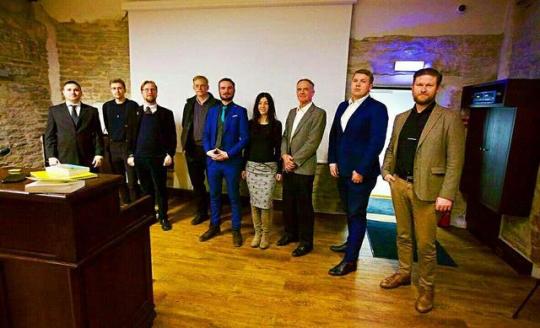
National Corps attended Etnofutur III conference in Tallinn (Conference Report)
February 23, National Corps took part in the Etnofutur III conference in Tallinn, which is for the third year in a row hosted by the youth organization of Estonian People's Conservative Party (EKRE), Blue Awakening (Sinine Äratus).
Under the skillfull leadership of Ruuben Kaalep, Tartu City Council member and the head of EKRE's Foreign Affairs office, it has become a rare point of attraction for renowned speakers from all over the world.
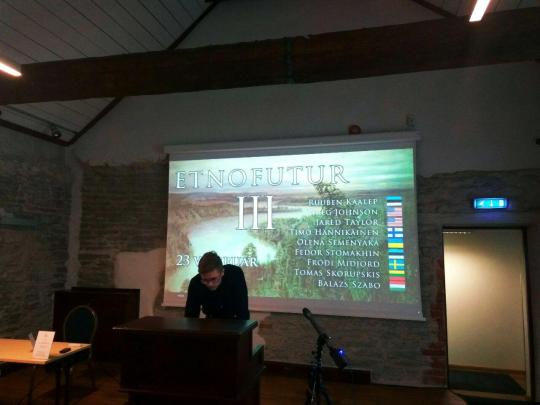
Traditionally, the strong emphasis has been laid on the conceptual synergy of the nationalist speakers of the Intermarium region. Once again, representatives of Sinine Äratus confirmed their substantive philosophical background which earned them international fame.
Ruuben Kaalep guarded the listeners through the existential journey paralleled with the new dawn in the fate of Europe, not forgetting to mention Martin Heidegger's diagnosis of the origins of decline, when identification with acts of thinking replaced openness to Being. Fedor Stomakhin presented a captivating piece on the strategies to neutralize and take the advantage of the leftist tendency in the established democratic procedures and the global marketing system. Co-written with another member of Sinine Äratus, Remi Sebastian Kits, it was their yet another profound contribution to the development of the conception of ethnofuturism.
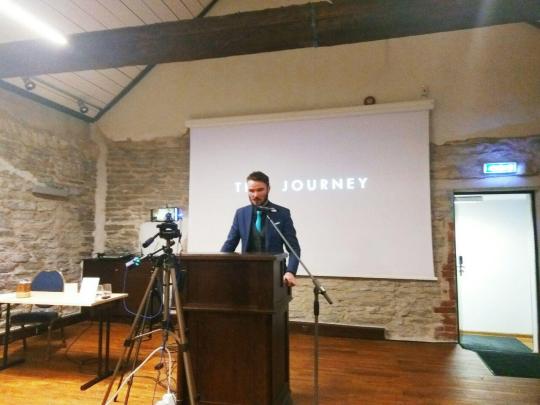
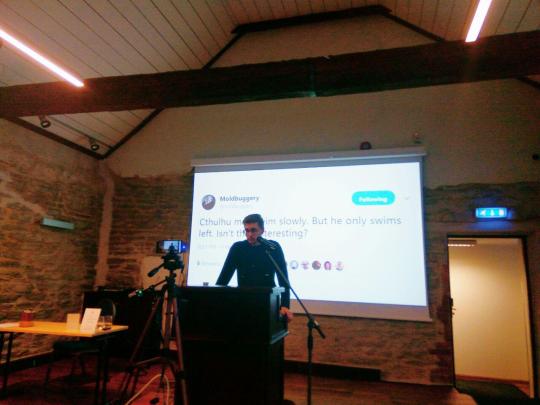
Success of Sinine Äratus is proven by the fact that another regular participant of Etnofutur conferences and a big enthusiast of Intermarium from Lithuania, Tomas Skorupskis, relaunched the youth wing of the Lithuanian Nationalist Union as the new ethnofuturist organization named Kryptis. Feb. 15-16, representative of National Corps Eugene Vriadnyk attended the Prabudimas conference and the massive torchlight march in honor of Lithuania's independence which were organized by Kryptis.
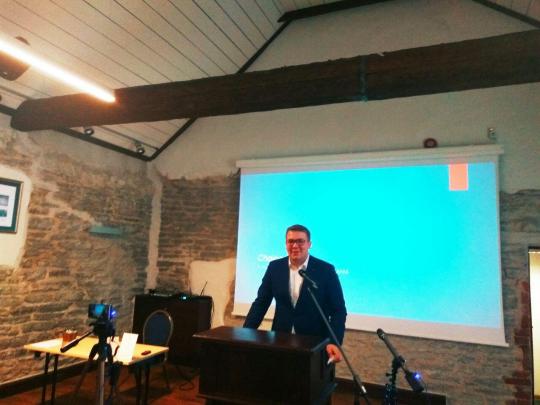
Olena Semenyaka, international secretary of National Corps and coordinator of the Intermarium Support Group, also continued elaborating the titular for this conference cycle conception in a speech entitled "Middle Europe in the Age of Caesarism and the Purpose of Ethnofuturism."
The brightest example of ethnofuturism as a combination of the policy of protecting ethno-cultural identities with innovative technologies, in her opinion, is the Azov Movement, which has long transcended the narrow party format. Dozens of social projects, educational programs, highly professional military structures, that's how should look like an all-Ukrainian patriotic movement of the 21st century which is well-prepared for the hybrid challenges of our time.

Having illustrated Oswald Spengler's concept of caesarism (the final period of the historic cycle of the West which began with the first world war) by the modern phenomenon of right-wing populism accompanied by military might, Olena Semenyaka presented Intermarium as the space where Old Europe can return to life again entering a new cultural and civilizational turn. Besides, she highlighted Ernst Jünger's philosophy of history efficiently incorporating, and neutralizing, the aforementioned left-leaning world-historical tendency.
Apart from developing the concept of ethnofuturism, which has strategic significance for the establishment of a regional union, National Corps came to Tallinn also in order to support a friendly organization on the eve of the parliamentary election in which EKRE will take part this weekend. According to exit polls, EKRE can count on 20 percent of electoral sympathies.
However, Estonia is not only a vanguard of the Baltic ethnofuturist studies. As a member of the Finno-Ugric ethnolinguistical family, Estonians are well-known for friendly ties with the Finns and the Hungarians, which makes their role in the consolidation of the Intermarium cooperation especially important.
Not incidentally, Etnofutur III conference was opened by MP Balazs Szabo representing quite famous in the international field Hungarian party Jobbik. Still, not everyone knows that Jobbik took a slightly different political course, and, currently, this is the biggest opposition party in Hungary. The reason is simple but valid enough to push Jobbik towards the temporary tactical alliance with the leftists: Balazs Szabo described Victor Orban's regime as the epitome of corruption and the right-populist illusion of real changes.
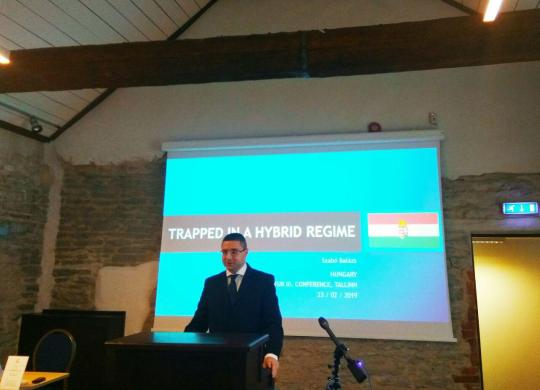
During and after the conference, Olena Semenyaka discussed with the Hungarian delegation the ways to neutralize the interethnic conflict in Transcarpathia, as well as to promote the natural for the region Intermarium union in Hungary.
On the eve of the Awakening conference in Finland, a long-anticipated agreement about the promotion of the Intermarium union was also reached with the Finnish conference participants. Timo Hännikäinen, a remarkable Finnish intellectual, publisher, editor-in-chief of the online magazine "Sarastus," leaved no doubts about the historical and cultural affinity between Ukraine and Finland in his inspiring speech at Etnofutur III conference in Tallinn, which laid a special emphasis on Carl Schmitt's concept of the political resting on the existential division between "us" and "them."
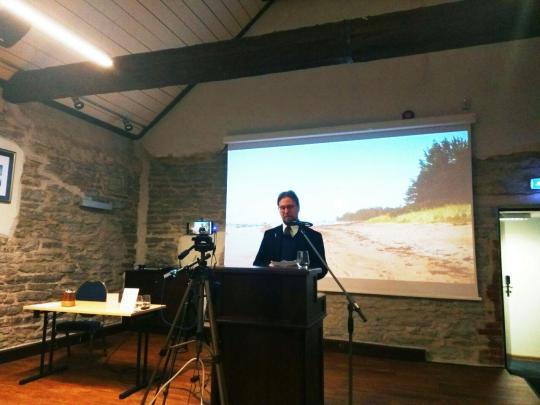
Currently, Ukrainian Intermarium Support Group plans in-depth familiarizing of the Finnish audience with the geopolitical project of Intermarium jointly with the youth organization of The Finns Party and the Finnish identitarian organization Suomen Sisu.
Froði Midjord (The Faroe Islands / Sweden), host of the Guide to Kulchur podcast and the founder of Scandza Forum, which, among others, will be attended by Olena Semenyaka in the end of March, brilliantly showed the absurdity of the unconscious hope of some activists on the Right to invoke sympathy of the political enemies by victimizing themselves and proving how good their real intentions are. The summary of his speech may be found here: https://www.counter-currents.com/2019/02/the-will-to-politics/
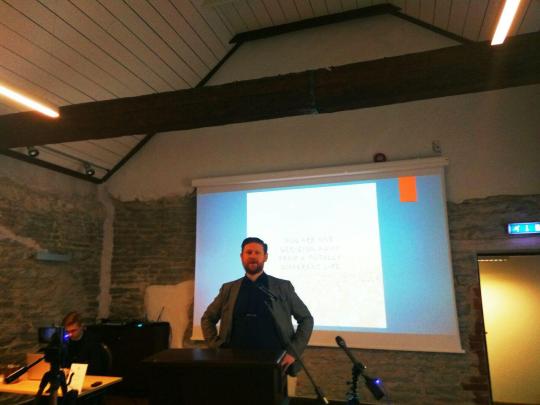
But Sinine Äratus is also well-known for their close ties with the Anglophone world and the American Alt-Right. Last year, it was represented by famous Scottish videoblogger Millennial Woes. This year, American "heavy artillery," Jared Taylor and Greg Johnson, carried away the audience by their flawless speeches, the former diagnosing the multicultural disorder of the Western sociocultural psyche, and the latter complementing it with quite a cheering reflection about the rise of national populism in the United States and Europe. Cheering for the nationalists and identitarians all over the world, upsetting for the globalists: at that very time, Greg Johnson's "Manifesto of White Nationalism" was banned from Amazon.

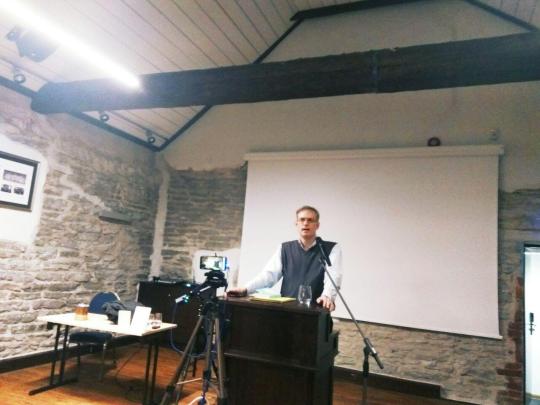
The conference was attended by more than 100 guests from Estonia and other European and American countries. The biggest interest to the project of Intermarium was naturally demonstrated by the representatives of the region's countries. However, Olena Semenyaka also had an fruitful conversation with the youth organization of the Italian party Lega, which, since recently, has been paying a growing attention to the political trends of Central and Eastern Europe and is preparing to form a powerful coalition in the European Parliament.
Having participated in organized by EKRE more than 10,000-strong torchlight march in honor of Estonia's independence across the beautiful medieval streets of Tallinn together with Latvian, Swedish, Lithuanian, Hungarian, Finnish, American, English and Canadian conference participants, Olena Semenyaka completed an intense and productive visit to Estonia by recording several video interviews for the Finnish and American media, as well as invited EKRE and the Etnofutur conference participants to the Fourth Conference of the Intermarium Support Group.
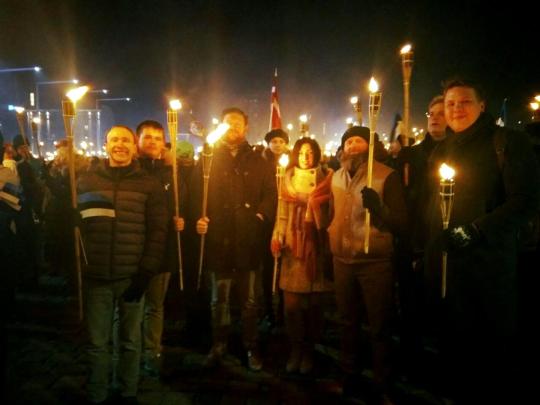
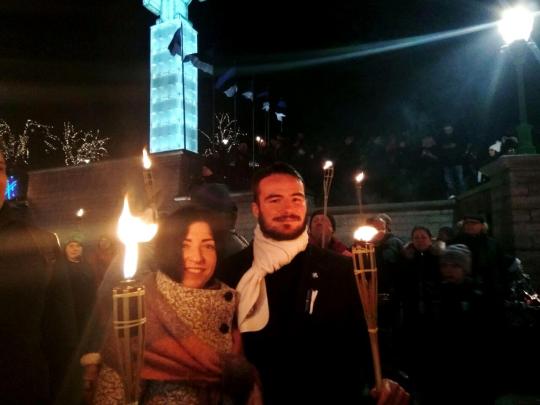
#Etnofutur#Sinine Aratus#EKRE#Estonia#Intermarium#National Corps#Ruuben Kaalep#Olena Semenyaka#AZOV movement
1 note
·
View note
Photo



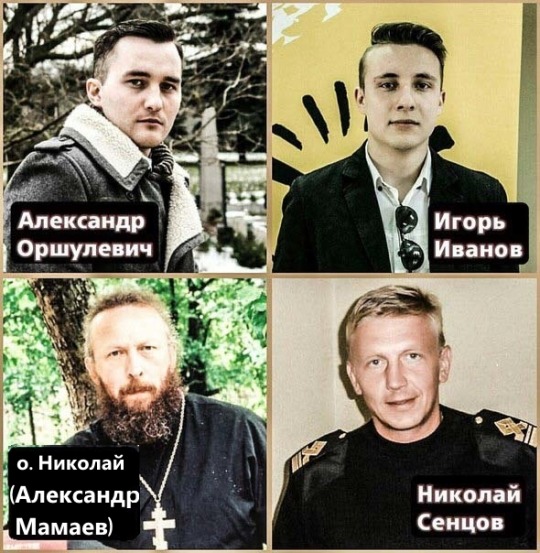
Russian Kaliningrad-based organization, BARS, faces life sentence for DISCUSSING geopolitical cooperation of former Königsberg with Eastern Europe and Germany
July 3, 2016, Russian conservative organization named BARS (Baltic Avant-Garde of Russian Resistance) took part in the non-governmental conference of the Intermarium Support Group at which its representative, young Igor Ivanov, discussed the prospects for geopolitical cooperation between the Kaliningrad region and the future Baltic-Black Sea Union (http://thenewnationalism.com/2016/07/27/inaugural-conference-intermarium-development-assistance-group-held-kyiv/).
The same month, BARS launched the petition to restore the German title of the city of Kaliningrad - Königsberg.
As a result, charged with making deaths threats against Russian president Vladimir Putin, as well as distributing "extremist materials," members of this conservative, basically, monarchist organization, were detained by the FSB in 2017 and currently face life sentences as a dangerous "terrorist organization."
The leader of the BARS, 30-year-old Alexandr Orshulevich, graduated from the Philosophical Department of the Faculty of History of the Immanuel Kant Baltic Federal University. His final qualifying work was called "The Vision of Russia in the Socio-Philosophical Reflection of V. Schubart and L. Müller." Alexandr has a wife, Vanda Orshulevich, and 4 little children: 2, 4, 6 and 8 years old.
Support the family of Alexandr Orshulevich: Sberbank card of Vanda Viktorovna Orshulevich 5469 2000 1370 9596
(Карта Сбербанка Ванды Викторовны Оршулевич 5469 2000 1370 9596)
Needless to say, when it comes to "securing the democratic rights of Ukrainians" by invading Donbas and annexing Crimea, Russian authorities instantly change the rhetoric and approaches.
International solidarity with Europe-friendly Russian prisoners of conscience does make a difference!
Read more (in Russian): https://www.novayagazeta.ru/articles/2019/01/25/79310-kapkan-na-barsa
0 notes